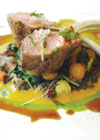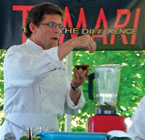
This lamb dish by chef Graham Elliot Bowles of the Peninsula Hotel in Chicago features crushed Altoids mints instead of mint jelly.
However, at Kendall College in Chicago—-one of America’s top culinary schools—the fourth year culinary students take a very unique class. It is a new type of course that teaches the “art” of successful innovation. Every young chef who passes that class learns what the special element is and how to use it. The secret ingredient is: courage.
True innovation means doing something totally new, something that no one has done before. By definition, it means taking a risk. Successful innovators take those risks and then tenaciously go forward—even when the experts, and maybe the bosses, say it is wrong. The world’s most innovative chefs are far out in front of the pack, imagining what might be rather than being bound by what already “works.” That misty place where new ideas are born is called the “fuzzy front end,” and trend-setters live there.
The most successful culinary innovator who ever lived might be Ray Kroc, the founder of McDonald’s. Kroc had the imagination to see what others could not, and he had the courage to make it into reality. He had a comfortable, successful life as a restaurant equipment salesman. Then one day, he decided to quit his job, put his future and family at risk—and he opened a restaurant concept that went completely against current wisdom. At the time, the “experts” told Kroc that his wild new concept was wrong. Despite their opinions, Kroc took the risk and created fast food; the rest is history.
Today, Burger King knows the secret, and they use it. Kevin Anderson is director of global product development, and chef Mark Dowding is head of product development in Europe. Both are courageous innovators. In Miami, Kevin steers BK’s global innovation efforts. From London, chef Dowding works alongside some of the world’s top chefs to make those dreams into reality. When the entire world was telling all of us that we needed to cut the carbs and eliminate cholesterol, Burger King had the courage to launch the Enormous Breakfast Sandwich. The launch was one of the most successful new breakfast items ever. Against the advice from almost every expert, Anderson used the secret ingredient. Courage wins the day. Burger King is setting trends, not chasing them.

Burger King’s chef Mark Dowding is the head of product development in Europe. BK successfully launched the Enormous Breakfast Sandwich during a time when healthier items garner much attention. PHOTO COURTESY OF CHEF J
Chef Dowding has a passion for excellence and a true love for innovation. When asked to share with us what city in the U.S. he feels is the best to visit to inspire culinary forward thinking, his answer was surprising. He said that some American cities are too focused on “their way” of doing things. San Francisco chefs may smugly disregard what is being developed in Minneapolis. Some New York chefs cannot even find Hong Kong on a map. What city does chef Dowding say is the one city most open-minded to other regions’ new culinary concepts, techniques and ideas? He says, “It’s Chicago!”
In the Windy City, the most successful, longest-lasting trend-setter is chef Rick Bayless. Since 1988, Bayless has won numerous awards and received recognition from many chefs’ associations and culinary magazines, including two James Beard Awards and a “Chef of the Year” award from the International Association of Culinary Professionals, to name a few.

Chef Rick Bayless is the founder of two award-winning Chicago concepts and is a leading authority on Mexican cooking. PHOTO COURTESY OF CHEF J
When America’s concept of Mexican food was greasy tacos and limp tamales, chef Bayless opened Topolobampo. One of America's very first fine-dining Mexican restaurants, both his Frontera Grill and Topolobampo concepts have received glowing distinctions from such publications as Gourmet, Food & Wine, Bon Appétit, Atlantic Monthly, Condé Nast Traveler and Zagat’s. In 2007, Frontera Grill was voted “America’s Best Restaurant” by the James Beard Foundation. Bayless now has two of the most successful, trendy restaurants in America.
As a famous celebrity chef, restaurant owner and published author, it was an easy jump to television. Now his “Mexico–One Plate at a Time” is one of the top-rated cooking shows on television. For most people, that would be more than enough for one lifetime, but not for a courageous culinary innovator. “Years after opening, I was approached by my now-partner in Frontera Foods, Manny Valdes,” Bayless recalls. “He presented the idea of a prepared foods line. It seemed like the next logical step, and I am glad that we took that step together.” When asked where he gets inspiration for his next new supermarket product, the chef went on to say, “Mexico! That is why I travel there so much. And I make sure that my staff travels with me. Every Fourth of July, we close the restaurant, and we take our staff to a different region in Mexico. When we come back to Chicago, we always create new items from our trip.”

Another entrée by chef Graham Elliot Bowles features Pop Rocks candies. He has also been known to use Rice Krispies® and candy canes in his artistic presentations. PHOTO COURTESY OF THE PENINSULA HOTEL
“Think outside the box”—we have all heard it. For most, it is easier said than done. Every food scientist is innovative. Every chef is passionate. Marketing executives are all creative by nature. Yet very few of us ever create and launch a truly world-class innovation. Thinking is easy. Many of us have the next big idea in our heads, right now. Now we need the secret to taking that concept to the next level. The secret ingredient is “the chef’s edge”—the secret ingredient is courage.